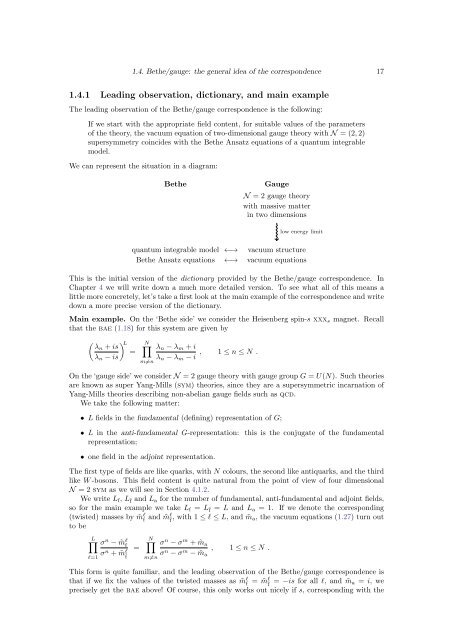The Bethe/Gauge Correspondence
The Bethe/Gauge Correspondence
The Bethe/Gauge Correspondence
You also want an ePaper? Increase the reach of your titles
YUMPU automatically turns print PDFs into web optimized ePapers that Google loves.
1.4. <strong>Bethe</strong>/gauge: the general idea of the correspondence 171.4.1 Leading observation, dictionary, and main example<strong>The</strong> leading observation of the <strong>Bethe</strong>/gauge correspondence is the following:If we start with the appropriate field content, for suitable values of the parametersof the theory, the vacuum equation of two-dimensional gauge theory with N = (2, 2)supersymmetry coincides with the <strong>Bethe</strong> Ansatz equations of a quantum integrablemodel.We can represent the situation in a diagram:<strong>Bethe</strong><strong>Gauge</strong>N = 2 gauge theorywith massive matterin two dimensionslow energy limitquantum integrable model ←→ vacuum structure<strong>Bethe</strong> Ansatz equations ←→ vacuum equationsThis is the initial version of the dictionary provided by the <strong>Bethe</strong>/gauge correspondence. InChapter 4 we will write down a much more detailed version. To see what all of this means alittle more concretely, let’s take a first look at the main example of the correspondence and writedown a more precise version of the dictionary.Main example. On the ‘<strong>Bethe</strong> side’ we consider the Heisenberg spin-s xxx s magnet. Recallthat the bae (1.18) for this system are given by( ) L λn + is=λ n − isN∏m≠nλ n − λ m + iλ n − λ m − i , 1 ≤ n ≤ N .On the ‘gauge side’ we consider N = 2 gauge theory with gauge group G = U(N). Such theoriesare known as super Yang-Mills (sym) theories, since they are a supersymmetric incarnation ofYang-Mills theories describing non-abelian gauge fields such as qcd.We take the following matter:• L fields in the fundamental (defining) representation of G;• L in the anti-fundamental G-representation: this is the conjugate of the fundamentalrepresentation;• one field in the adjoint representation.<strong>The</strong> first type of fields are like quarks, with N colours, the second like antiquarks, and the thirdlike W -bosons. This field content is quite natural from the point of view of four dimensionalN = 2 sym as we will see in Section 4.1.2.We write L f , L¯f and L a for the number of fundamental, anti-fundamental and adjoint fields,so for the main example we take L f = L¯f = L and L a = 1. If we denote the corresponding(twisted) masses by ˜m l f and ˜ml¯f , with 1 ≤ l ≤ L, and ˜m a , the vacuum equations (1.27) turn outto beL∏l=1σ n − ˜m l fσ n + ˜m l¯f=N∏m≠nσ n − σ m + ˜m aσ n − σ m − ˜m a, 1 ≤ n ≤ N .This form is quite familiar, and the leading observation of the <strong>Bethe</strong>/gauge correspondence isthat if we fix the values of the twisted masses as ˜m l f= ˜m l¯f = −is for all l, and ˜m a = i, weprecisely get the bae above! Of course, this only works out nicely if s, corresponding with the
















